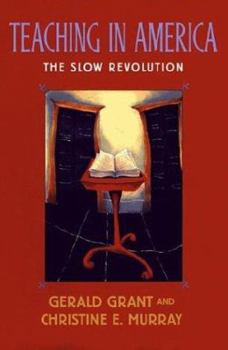Teaching in America: The Slow Revolution
Select Format
Select Condition 
Book Overview
If the essential acts of teaching are the same for schoolteachers and professors, why are they seen as members of quite separate professions? Would the nation's schools be better served if teachers... This description may be from another edition of this product.
Format:Hardcover
Language:English
ISBN:0674869613
ISBN13:9780674869615
Release Date:March 1999
Publisher:Harvard University Press
Length:280 Pages
Weight:1.22 lbs.
Dimensions:0.9" x 6.4" x 9.5"
Customer Reviews
3 ratings
Unique perspective and storyline
Published by Thriftbooks.com User , 20 years ago
Teaching in America offers a unique history of education from the perspective of the developing meaning of "teaching." By comparing the worlds of school teachers and college teachers over history, the authors expose stressfull points in educational history that have shaped todays' discourse on education. While some of the text is written as intellectual history, a great deal of it is really a sociological analysis of the authors past personal experiencies and the challenges of past times. The result for the reader is a unique perspective and insight into a rarely studied period in recent history.The lessons to be learned from these experiences are different than those suggested by other recent literature in educational history. In contrast to the conclusions of some of the other literature, this text suggests that the social challenges in education are tied to the conflicting goals we hold for teachers, students, men, women, etc. While each of these themes is explored elesewhere in the literature, they are brought together here in the experiences of two experienced teachers.
How come history takes such a long time?
Published by Thriftbooks.com User , 23 years ago
The authors relate that the paradigm shift in American education has necessarily taken a long time. Still, the systems do change and are changing and their book may be one more stone for completely the arch of change. What I found most helpful was their stress on teacher empowerment in enacting change. Their research indicates that teachers need less layers of administrative control and more opportunities for entrepreneurial decisions in shaping their learning communities, in determining budget issues, in establishing curriculum and assessments. They applaud recent movemont for fair and rigorous assessments, not only of students but of teachers. If teacher's standards are raised as an educational community, expect respect (financially, socially) to be credited to them. To do this, teachers also need more peer control of their services, control in rating and evaluating each other, and in helping each other find opportunities for collaboration. The results will build better schools beyond the verbiage that blows hard during political years.I became somewhat bogged down in reading it during the middle chapters. The lengthy reports of how schools have sabotaged their own success, although necessary reading and well presented(especially if one is considering entering education or has just entered the profession), seemed droll. For me, it slowed the journey of reading down. But definitely read it to the end. Their book would be a good, educational companion suggestion next to Peter Senge's The Fifth Discipline.
Teacher professionalism: the past and the future.
Published by Thriftbooks.com User , 24 years ago
"Teaching in America: The slow revolution" is a good read. Particularly interesting, for me, was the history of the developing professionalism of teachers. The authors make the point that the first revolution, brilliantly captured by Callahan (Education and the Cult of Efficiency) which saw the rise of the administrator class while teachers "... remained locked in a (sic.) hierachical system in which they were treated as hirelings whose work was mandated by a male administrative elite."The authors argue passionately for a second revolution in teaching which will see teachers recognised as valued professionals. However the price that must be paid, according to the authors, is that teachers need to "... convince the public that they have the will and capacity to make judgments about who is fit to teach and who should be dismissed for incompetence. Teachers must show that they have standards by which their peers will be judged ...."The growth of teacher professionalism and autonomy will clearly be at the expense of current administrative roles and this is not examined in depth in the book.Chapter 9 - Teaching in 2020 was excellent and in a section called "Contrasts between the two revolutions" the points examined are: The nature of peer control; Allocation of time and money; Credibility, serving the public good; A revolution by women; Pressure for more egalitarian outcomes; The nature of markets for professional skills; and Sharing authority with parents.I thought the book presented lots of useful information and thought that the argument that teaching was devalued among professions because (among other things) it was seen as women's work was a call to arms. Teaching in America is a book that should be placed in the professional reading section for teachers in every school.






